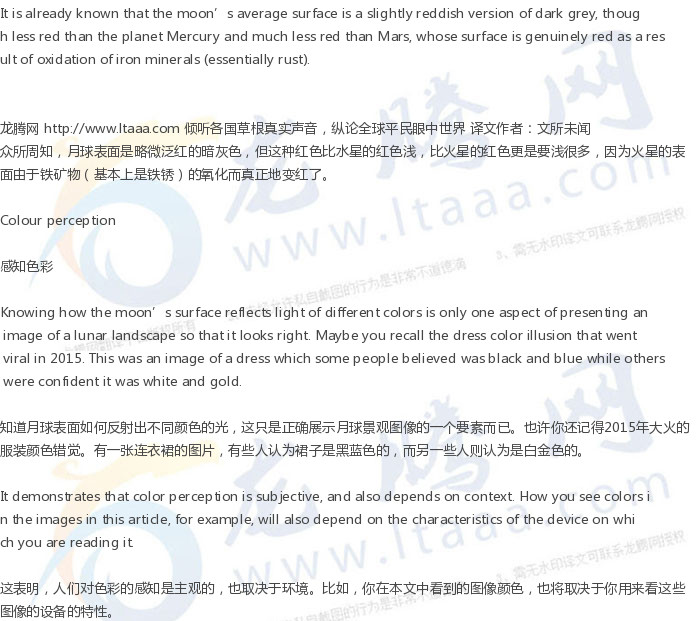科学解释:为什么嫦娥4号拍摄的月球背面照片看起来泛红? [美国媒体]
中国国家航天局(CNSA)成功登陆月球,随后首次公布了在月球背面地表拍摄的照片。在“嫦娥4号”着陆器和“玉兔2号”月球车之前,中国国家航天局于2013年在月球正面已经部署了“嫦娥3号”和原“玉兔号”。
Chang'e 4: why the moon’s far side looks red in new images
科学解释:为什么嫦娥4号拍摄的月球背面照片看起来泛红?
It's not actually dark and it's definitely not red.
事实上,嫦娥4号拍摄的月球背面照片并不是黑白的,但也绝不会是红色的。
The first ever images taken from the surface of the far side of the moon have been released following the Chinese National Space Administration’s (CNSA) successful landing there. The lander Chang'e 4 and rover Yutu 2 follow from Chang'e 3 and the original Yutu rover that were deployed on the moon’s near side in 2013.
中国国家航天局(CNSA)成功登陆月球,随后首次公布了在月球背面地表拍摄的照片。在“嫦娥4号”着陆器和“玉兔2号”月球车之前,中国国家航天局于2013年在月球正面已经部署了“嫦娥3号”和原“玉兔号”。
The first picture below is an example of one such “raw” image. In the raw version, the lunar surface looks red because the detectors used were more sensitive to red than they were to blue or green.
下面第一张图片是这种“原始”图像的示例。在原始版本中,月球表面看起来是红色的,因为相比蓝色或绿色,嫦娥4号上相机使用的颜色识别器对红色更加敏感。
So although in truth the surface is almost equally bright in all three colors, the green and blue detectors have been set up so as to be less sensitive to light than the red detectors.
因此,尽管事实上这所有三种颜色在月球背面地表的亮度几乎都是一样的,但绿色和蓝色的颜色识别器已经被设置好了,所以它们对光的敏感度要低于红色的颜色识别器。
Calibrating colors
校准色彩
The British Beagle2 lander on Mars, which landed successfully in 2003 but failed to communicate, famously carried a color calibration target in the form of a Damien Hirst artwork. NASA’s Mars Curiosity rover carries color calibration targets too.
英国“小猎犬2号”火星着陆器于2003年成功着陆,但与地面通讯失败。它以携带了(英国画家)达米恩·赫斯特绘制的一个颜色校准片而闻名。美国宇航局的火星探测器“好奇心”同样也携带颜色校准片。
However, the images from the Chang'e 4 lander and the Yutu 2 rover are primarily for navigation purposes, for which getting the color right scarcely matters.
但是,来自嫦娥4号着陆器和玉兔2号月球车的图像主要是用于导航目的,因此是否捕获正确的颜色几乎不重要。
There is some useful science in measuring how well the rocks and minerals on an extraterrestrial surface reflect light of different colors, and the Yutu 2 rover carries a “visible and near infrared spectrometer” designed to do just this so we can learn more about the surface composition.
一些实用的科学技术能够测量到外星地表的岩石和矿物反射不同颜色光的能力,玉兔 2月球车携带了一个“可见光近红外光谱仪”,目的就是做到这一点,以便我们能了解更多关于月球表面成分的信息。
However, measurements show that there is very little color variation on the moon, and astronauts who have been there will all tell you that the moon is essentially drab grey (partly explaining the excitement when a layer of orange soil was spotted). When the first Chinese astronaut walks on the moon—probably sometime in the 2020s—they will most likely experience the same thing.
然而,数据显示月球颜色没有很大的变化,曾经到过那里的宇航员都会告诉你月球基本上是单调的灰色(这一定程度生也解释了当时他们发现一层橙色土壤的兴奋)。当第一位中国宇航员在月球上行走时(很可能将在20世纪20年代的某个时候),他们也会经历同样的事情。
版权声明
我们致力于传递世界各地老百姓最真实、最直接、最详尽的对中国的看法
【版权与免责声明】如发现内容存在版权问题,烦请提供相关信息发邮件,
我们将及时沟通与处理。本站内容除非来源注明五毛网,否则均为网友转载,涉及言论、版权与本站无关。
本文仅代表作者观点,不代表本站立场。
本文来自网络,如有侵权及时联系本网站。
图文文章RECOMMEND
热门文章HOT NEWS
-
1
Why do most people who have a positive view of China have been to ...
- 2
- 3
- 4
- 5
- 6
- 7
- 8
- 9
- 10
推荐文章HOT NEWS
-
1
Why do most people who have a positive view of China have been to ...
- 2
- 3
- 4
- 5
- 6
- 7
- 8
- 9
- 10















